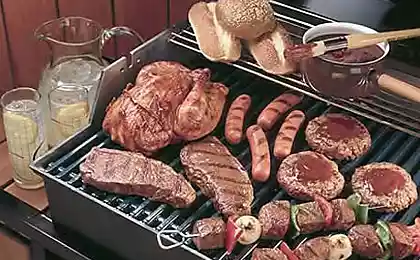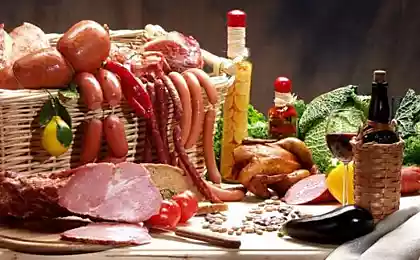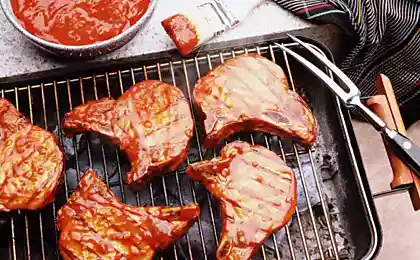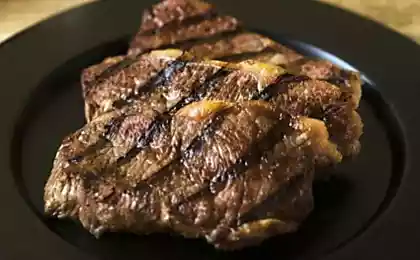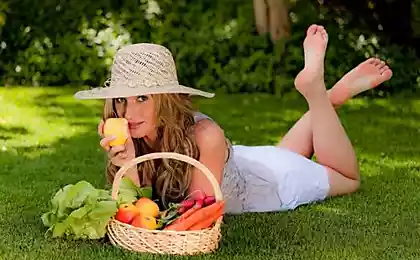918
Neither fish nor fowl
In the picture - a brave crew of the catamaran "Panderihtis Great" River Fish. The name of the vessel were born on the way to the train, where we read a newspaper article about the recent discovery of this wonderful creature. Ram on the site of the cut-soaked spring birch sap Lesin, resulting in a piece of plate got a big, strong, unsinkable, tenacious, chetyrehveselnoy, heavy, low-speed and extremely ill-suited to move on land ... what am I doing? And besides, about the same as having his prehistoric prototype - fish panderiht (Panderichthys). And it will have on our fish-like ancestors.
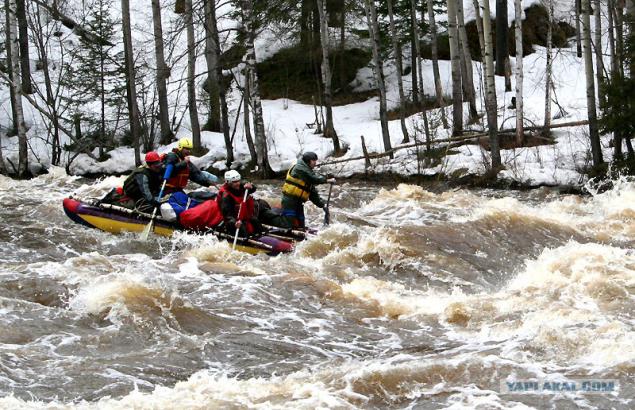
The remains of creatures that could be a transitional link from fish to amphibians, found a lot - at least 20 species - but who among them was our ancestor (or maybe it was like for them, but found still exist) - Unknown .
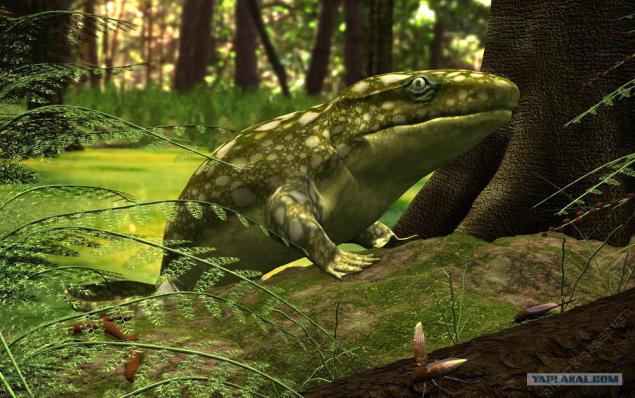
Many major evolutionary "breakthroughs" (such as the output of fish on land, the origin of the arthropods, birds, mammals, angiosperms, and others.) Carried out a kind of "joint efforts" of several developing in parallel lines, independently of one another have gained a similar progressive features. That is, there is a new ecological niche and / or the possibility of a group of beings have for its development - and different populations independently evolved roughly in the same direction, giving rise to many a race in general or similar new types. Survive in the end, displacing others, descendants of only one of these "teams", were the most successful: for example, of all the birds flying dinosaur is a bird appeared, of all people- Homo sapiens.
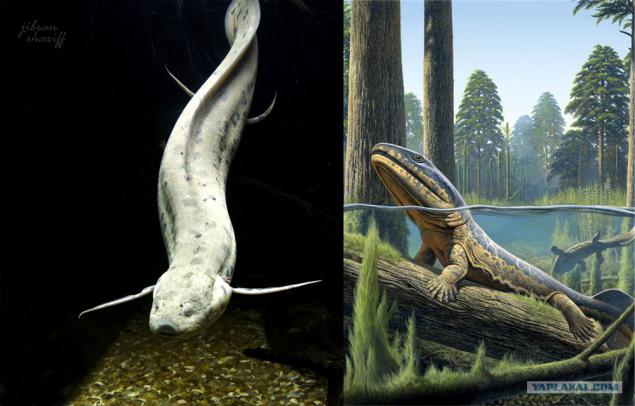
So, similar to each other fishlike creatures, pretend that their descendants were the first land animals in the Devonian period was pretty much, and not all varieties are known. It is not clear whether it was someone from the herein described species (in some respects, perhaps not), but in any case, it was someone they really like. Just do not know how to call them - fish or amphibians because they combine features of both those, and others - therefore the term "early tetrapods."
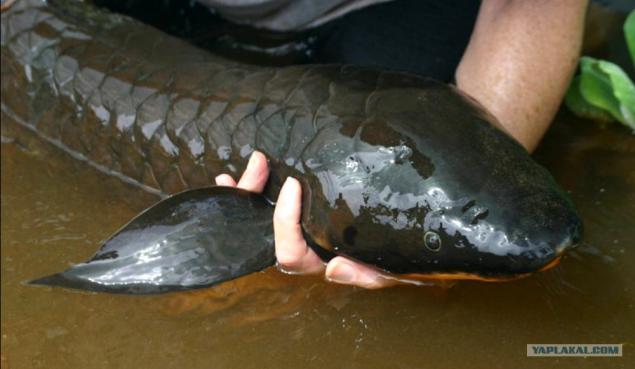
To understand why there were these creatures, you must first answer the question "when?" And "Where?" So, the first four-legged fossils found in sedimentary rocks, formed from the middle to the end of the Devonian (385-360 million years ago), and former once part of the ancient continent of red sandstone (Old Red Sandstone, or just Oldred). To relate it to the current continents, it is necessary to cut off Europe to the Urals and turn it 90 ° counterclockwise and North America, on the contrary - in the 90 ° clockwise, and tightly close them so that Greenland joined with Scandinavia. It is necessary to move the earth to zero latitude (Africa was then further south - as part of Gondwana) and partially flood the oceans - will Aldred.

Aldred was surrounded by wide shallows sea, blending smoothly into the band Tide. At the heart of the continent settled lowlands busy drying up from time to time, marshes, lakes and deliberately shallow rivers, and terrain is constantly changing in the lack of ability to live away from bodies of water higher plants, whose roots impede erosion, water is actively eroded hillsides, cutting deep canyons, and at the exit to the plains to create a network of loose sediments, which today can be seen only in the river deltas. In fact, most of the continent was a single large river delta, but without the huge river. Add to this the alternating seasons of tropical storms and droughts - and get the habitat where the boundary of water and land completely blurred.

Sredneplanetnaya temperature at the time was three degrees higher than today (and hence, in some places near the equator it is sometimes just damn hot), and carbon dioxide was ten times more than today - 0, 3%. These conditions contributed to a very photosynthesis - sea algae were abundant, and the shore and shallow waters of the continental waters thickets first "trees" with a strong root system, unable, however, to live without constant moistening roots. The role of the leaves, is a rather pathetic whisk, these plants play zalenaya bark, which periodically overfly. As a result, in the coastal zone for the first time formed a thick layer of soil and decaying organic matter on an unprecedented scale was the first drain into lakes, rivers and the surrounding shallow sea. Oxygen reservoirs (which and so sparsely in warm stagnant water) is almost entirely left to the oxidation of organic matter, and the fish was nothing left to do, how to learn to use breathing ambient air. Not such a prodigy in the world of fish - popular among aquarists labyrinth fish used for this special organ located in nadzhabernoy cavity and dvoyakodyshaschme whose ancestors were just in Devon - a modified swim bladder. And those and others can suffocate in the water if they do not give a trap air from the surface. The ancient Crossopterygii ripidisty from the group, who were the ancestors of tetrapods, a prototype of light, according to the structure of amphibian embryos became obviously paired outgrowths of the pharynx - the converted additional gill pockets.

Gourami. Labirintovaya fish
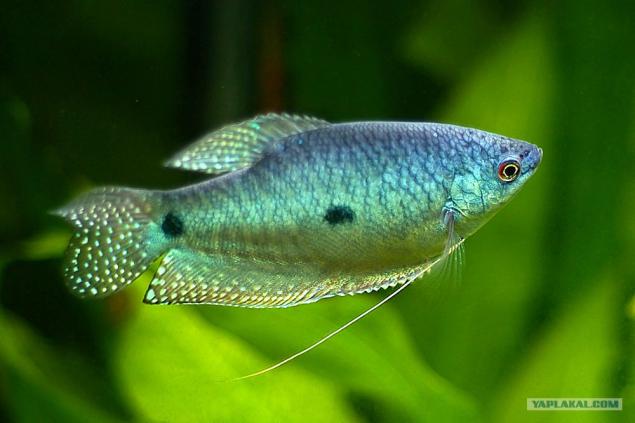
The saltwater lagoon off the east coast Aldred 385 million years ago lived panderihty - large, about a meter long fish - yet still fish - which were first distinct adaptations for movement on land. After 5 million years in the inland parts of the continent appeared Tiktaalik - even larger predators with improved skeleton flippers. On the discovery of the remains of the fish in the Arctic Ellesmere Island, owned by Canada, became known in 2006.
Panderiht

Tiktaalik
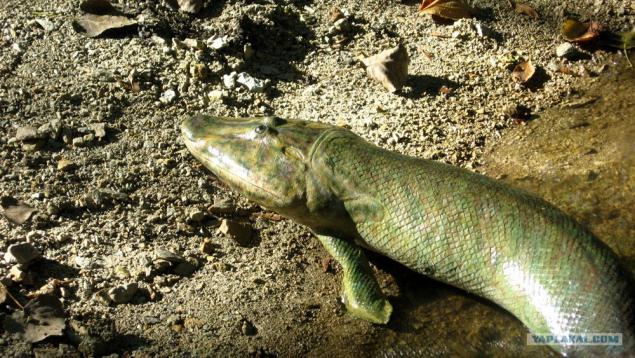
Both had an elongated body with no dorsal fin, covered with thick scales rhombic, short tail and elongated snout with very strong teeth. The eyes of these predators were on the face, like a crocodile, and allows you to monitor the situation above the water line, and the eyes of these were three: two large and one small

And most importantly - their pectoral and pelvic fins were not a "fan" like a ray-finned and muscular fins. And then the question - why do they have such fins? To move on land they practically were not good - they did not have "wrists" and "ankle", and they do not end with your fingers, and fine trim as usual fish fins. And I must say, to move on land - for example, to crawl out of a dried puddle in not quite dried up - certainly not particularly something and need. Acne, for example, perfectly cope with this without them, not to mention snakes. If you watch only today predstvaitelyami Crossopterygii - coelacanth (dead end, was taken over by the clean sea of life) - we can see that they use their fins as paddles (with the paddle "criss-cross" - both the right front and left rear, then the left front and right rear - just like the majority of four-legged walking) and rudders - the latter was especially important for panderihta and Tiktaalik, hunting in overgrown shallow waters, where agility is more important than speed. In addition, these fins was convenient to "walk" along the bottom (especially in the shallows, when the back sticking out) and resting on the bottom, push the bushes growing "in-the water," grass helophytes - hardly these fish often had to swim in the open water , and they were there without the dorsal and anal fins are clumsy.
The picture tends panderiht zahavali asterolepisa - pantsirntsyu fish, not an ancestor one of the living, but nevertheless worth considering. This is another occupant of the Devonian freshwater marshes and creeks, which initially took it for an intermediate between fish and turtles, then all of the arthropod. The fact that all of the armor-clad body, and the pectoral fins are like crab legs, because generally no bones - only the exoskeleton. These tough long fins clearly not very suitable for swimming, but with a sharp tip at least have Crossopterygii, good for movement along the bottom or shore. That's for them to climb on land limbs were needed - to wriggle like a snake dressed in the armor of the body could not. Surely they, too, could breathe the air, and on the other the evolution Go to print these lines I would claw ...
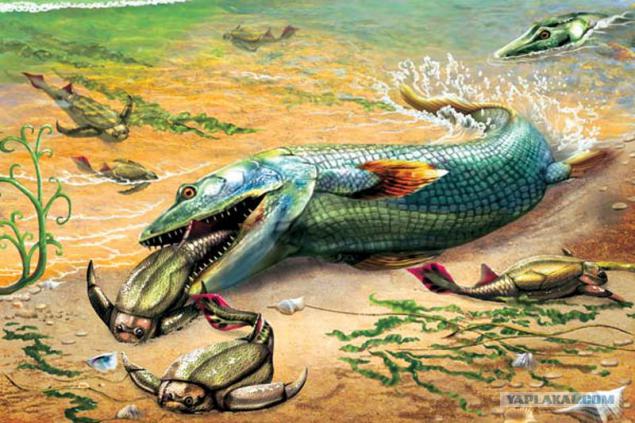
13.
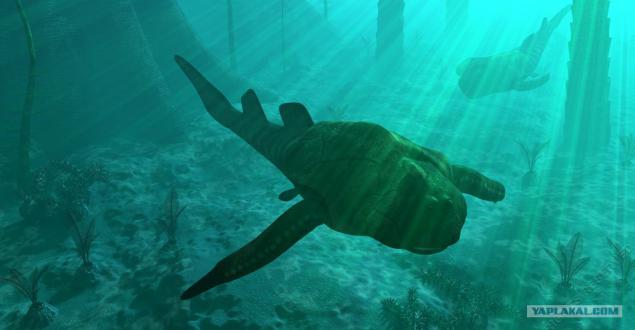
14.

From gills - at least in the form of fish klassichesokom - Tiktaalik confused with panderihtom were few and zheberny unit reduced (although the gills are preserved). Most fish skeleton forelimb - pectoral fin - is attached to the skeleton of the gill cover. And the fish is convenient: they synchronize the movement of the gill covers and the pectoral fins, and thus breathe. Tiktaalik have nearly all the bones of the gill cover disappeared, but an opportunity to turn his head, and the remnants of gill arches began to slow, but it is extremely important for all terrestrial tetrapods journey inside the skull - their descendants, they will turn to the auditory ossicles. These fish are not air inhaled and swallowed - because they have such a wide and flat characteristic of all amphibians, a muzzle. To refuse such a shape of the head being able to land only when evolution "invented" phrenicocostal breath. It was then that the evolution of the descendants of amphibian skull and went their separate ways ...
Approximately 365 million years ago, there were descendants Crossopterygii Aldred, which has every right to be called the first tetrapods, although they were almost the same lifestyle as the aforementioned panderiht. It is best to have studied Acanthostega and Ichthyostega, found in Greenland and tulerpeton from the Tula region (of the center and east Aldred, respectively). Many have still remained of the fish - have been developed Acanthostega internal gills and tail fin and belly including advanced tulerpetona covered with fish scales. But what makes them fully-fledged four-legged, so it's real fingers on the feet. In Acanthostega - eight, at Ichthyostega - seven have tulerpetona - six.
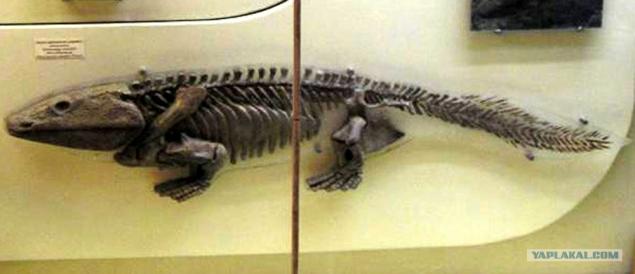
16.Ihtiostega. Previously it was thought that they were moved by land like modern lizards, or, say, the salamanders: wriggling. However, recent studies suggest that Ichthyostega move so just could not, because it interferes with the specific structure of its spine, the spine is more like a land animal than amphibians. In addition, the front and rear pairs of paws Ichthyostega were not the same. If the front is actually a pair of legs is, the rear is more like sealskin fins. Accordingly, the creature on land rather than passed around as crawling, throwing forward the front part of the case, fixed on the legs and pulling for themselves back, look more like a Martian spilbergovskoy of "War of the Worlds" than a lizard
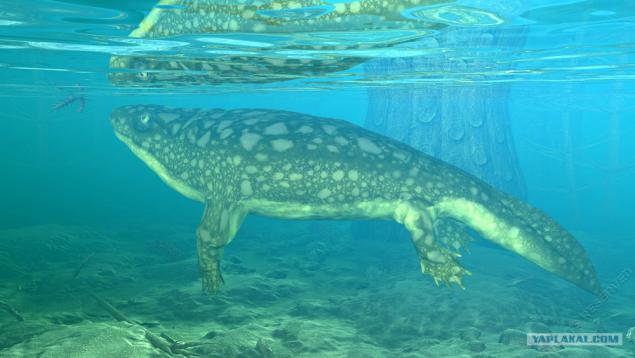
Acanthostega. Although the structure of its skeleton indicates an internal gills (like Ichthyostega, however), and weak limbs that could not withstand the weight of the animal, and short ribs, which it also could not rely, say that they are for throughout his life he feels great in the water.
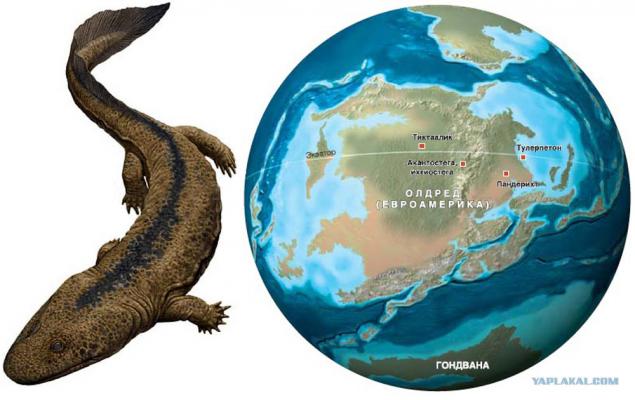
More advanced was tulerpeton. His hind legs even more advanced than the front, and have a "brick wall" of the small bones in the ankle area, which allows the use of their full overland.

However, his feet still more suited to push the body on the soft wet ground than walking. on the feet and toes it was probably not so much a tool for ground movement, as all the same effective means to cling to the bottom or underwater vegetation, like outgrowths on the fins of some modern fish like Sargassum clowns.
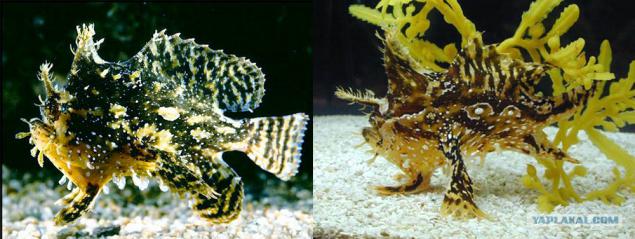
So the ancestors of terrestrial creatures, continuing as far as possible, to sit in the water and leaving it is likely only when the drying of ponds or exhaustion, slowly acquired practically all the basic tools for the conquest of the land. Only here to win it for a long time were in no hurry. For, as he wrote Eskov "in Devon focused landfall would even gamble, but something in the category of masochism ... that they, in fact, could find on the land - in addition to overload due to multiple increase of its own weight, heatstroke so deadly dehydration? .. Food? What kind of food - in the Devonian period some? "Creatures of the full right could be called amphibians, appeared only at the end of the Devonian, and bred in the next - the Carboniferous period. But that's another story.
Everything.
© haritonoff
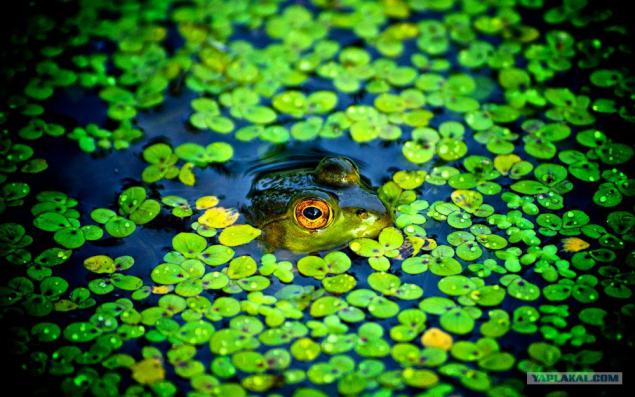
Source:

The remains of creatures that could be a transitional link from fish to amphibians, found a lot - at least 20 species - but who among them was our ancestor (or maybe it was like for them, but found still exist) - Unknown .

Many major evolutionary "breakthroughs" (such as the output of fish on land, the origin of the arthropods, birds, mammals, angiosperms, and others.) Carried out a kind of "joint efforts" of several developing in parallel lines, independently of one another have gained a similar progressive features. That is, there is a new ecological niche and / or the possibility of a group of beings have for its development - and different populations independently evolved roughly in the same direction, giving rise to many a race in general or similar new types. Survive in the end, displacing others, descendants of only one of these "teams", were the most successful: for example, of all the birds flying dinosaur is a bird appeared, of all people- Homo sapiens.

So, similar to each other fishlike creatures, pretend that their descendants were the first land animals in the Devonian period was pretty much, and not all varieties are known. It is not clear whether it was someone from the herein described species (in some respects, perhaps not), but in any case, it was someone they really like. Just do not know how to call them - fish or amphibians because they combine features of both those, and others - therefore the term "early tetrapods."

To understand why there were these creatures, you must first answer the question "when?" And "Where?" So, the first four-legged fossils found in sedimentary rocks, formed from the middle to the end of the Devonian (385-360 million years ago), and former once part of the ancient continent of red sandstone (Old Red Sandstone, or just Oldred). To relate it to the current continents, it is necessary to cut off Europe to the Urals and turn it 90 ° counterclockwise and North America, on the contrary - in the 90 ° clockwise, and tightly close them so that Greenland joined with Scandinavia. It is necessary to move the earth to zero latitude (Africa was then further south - as part of Gondwana) and partially flood the oceans - will Aldred.

Aldred was surrounded by wide shallows sea, blending smoothly into the band Tide. At the heart of the continent settled lowlands busy drying up from time to time, marshes, lakes and deliberately shallow rivers, and terrain is constantly changing in the lack of ability to live away from bodies of water higher plants, whose roots impede erosion, water is actively eroded hillsides, cutting deep canyons, and at the exit to the plains to create a network of loose sediments, which today can be seen only in the river deltas. In fact, most of the continent was a single large river delta, but without the huge river. Add to this the alternating seasons of tropical storms and droughts - and get the habitat where the boundary of water and land completely blurred.

Sredneplanetnaya temperature at the time was three degrees higher than today (and hence, in some places near the equator it is sometimes just damn hot), and carbon dioxide was ten times more than today - 0, 3%. These conditions contributed to a very photosynthesis - sea algae were abundant, and the shore and shallow waters of the continental waters thickets first "trees" with a strong root system, unable, however, to live without constant moistening roots. The role of the leaves, is a rather pathetic whisk, these plants play zalenaya bark, which periodically overfly. As a result, in the coastal zone for the first time formed a thick layer of soil and decaying organic matter on an unprecedented scale was the first drain into lakes, rivers and the surrounding shallow sea. Oxygen reservoirs (which and so sparsely in warm stagnant water) is almost entirely left to the oxidation of organic matter, and the fish was nothing left to do, how to learn to use breathing ambient air. Not such a prodigy in the world of fish - popular among aquarists labyrinth fish used for this special organ located in nadzhabernoy cavity and dvoyakodyshaschme whose ancestors were just in Devon - a modified swim bladder. And those and others can suffocate in the water if they do not give a trap air from the surface. The ancient Crossopterygii ripidisty from the group, who were the ancestors of tetrapods, a prototype of light, according to the structure of amphibian embryos became obviously paired outgrowths of the pharynx - the converted additional gill pockets.

Gourami. Labirintovaya fish

The saltwater lagoon off the east coast Aldred 385 million years ago lived panderihty - large, about a meter long fish - yet still fish - which were first distinct adaptations for movement on land. After 5 million years in the inland parts of the continent appeared Tiktaalik - even larger predators with improved skeleton flippers. On the discovery of the remains of the fish in the Arctic Ellesmere Island, owned by Canada, became known in 2006.
Panderiht

Tiktaalik

Both had an elongated body with no dorsal fin, covered with thick scales rhombic, short tail and elongated snout with very strong teeth. The eyes of these predators were on the face, like a crocodile, and allows you to monitor the situation above the water line, and the eyes of these were three: two large and one small

And most importantly - their pectoral and pelvic fins were not a "fan" like a ray-finned and muscular fins. And then the question - why do they have such fins? To move on land they practically were not good - they did not have "wrists" and "ankle", and they do not end with your fingers, and fine trim as usual fish fins. And I must say, to move on land - for example, to crawl out of a dried puddle in not quite dried up - certainly not particularly something and need. Acne, for example, perfectly cope with this without them, not to mention snakes. If you watch only today predstvaitelyami Crossopterygii - coelacanth (dead end, was taken over by the clean sea of life) - we can see that they use their fins as paddles (with the paddle "criss-cross" - both the right front and left rear, then the left front and right rear - just like the majority of four-legged walking) and rudders - the latter was especially important for panderihta and Tiktaalik, hunting in overgrown shallow waters, where agility is more important than speed. In addition, these fins was convenient to "walk" along the bottom (especially in the shallows, when the back sticking out) and resting on the bottom, push the bushes growing "in-the water," grass helophytes - hardly these fish often had to swim in the open water , and they were there without the dorsal and anal fins are clumsy.
The picture tends panderiht zahavali asterolepisa - pantsirntsyu fish, not an ancestor one of the living, but nevertheless worth considering. This is another occupant of the Devonian freshwater marshes and creeks, which initially took it for an intermediate between fish and turtles, then all of the arthropod. The fact that all of the armor-clad body, and the pectoral fins are like crab legs, because generally no bones - only the exoskeleton. These tough long fins clearly not very suitable for swimming, but with a sharp tip at least have Crossopterygii, good for movement along the bottom or shore. That's for them to climb on land limbs were needed - to wriggle like a snake dressed in the armor of the body could not. Surely they, too, could breathe the air, and on the other the evolution Go to print these lines I would claw ...

13.

14.

From gills - at least in the form of fish klassichesokom - Tiktaalik confused with panderihtom were few and zheberny unit reduced (although the gills are preserved). Most fish skeleton forelimb - pectoral fin - is attached to the skeleton of the gill cover. And the fish is convenient: they synchronize the movement of the gill covers and the pectoral fins, and thus breathe. Tiktaalik have nearly all the bones of the gill cover disappeared, but an opportunity to turn his head, and the remnants of gill arches began to slow, but it is extremely important for all terrestrial tetrapods journey inside the skull - their descendants, they will turn to the auditory ossicles. These fish are not air inhaled and swallowed - because they have such a wide and flat characteristic of all amphibians, a muzzle. To refuse such a shape of the head being able to land only when evolution "invented" phrenicocostal breath. It was then that the evolution of the descendants of amphibian skull and went their separate ways ...
Approximately 365 million years ago, there were descendants Crossopterygii Aldred, which has every right to be called the first tetrapods, although they were almost the same lifestyle as the aforementioned panderiht. It is best to have studied Acanthostega and Ichthyostega, found in Greenland and tulerpeton from the Tula region (of the center and east Aldred, respectively). Many have still remained of the fish - have been developed Acanthostega internal gills and tail fin and belly including advanced tulerpetona covered with fish scales. But what makes them fully-fledged four-legged, so it's real fingers on the feet. In Acanthostega - eight, at Ichthyostega - seven have tulerpetona - six.

16.Ihtiostega. Previously it was thought that they were moved by land like modern lizards, or, say, the salamanders: wriggling. However, recent studies suggest that Ichthyostega move so just could not, because it interferes with the specific structure of its spine, the spine is more like a land animal than amphibians. In addition, the front and rear pairs of paws Ichthyostega were not the same. If the front is actually a pair of legs is, the rear is more like sealskin fins. Accordingly, the creature on land rather than passed around as crawling, throwing forward the front part of the case, fixed on the legs and pulling for themselves back, look more like a Martian spilbergovskoy of "War of the Worlds" than a lizard

Acanthostega. Although the structure of its skeleton indicates an internal gills (like Ichthyostega, however), and weak limbs that could not withstand the weight of the animal, and short ribs, which it also could not rely, say that they are for throughout his life he feels great in the water.

More advanced was tulerpeton. His hind legs even more advanced than the front, and have a "brick wall" of the small bones in the ankle area, which allows the use of their full overland.

However, his feet still more suited to push the body on the soft wet ground than walking. on the feet and toes it was probably not so much a tool for ground movement, as all the same effective means to cling to the bottom or underwater vegetation, like outgrowths on the fins of some modern fish like Sargassum clowns.

So the ancestors of terrestrial creatures, continuing as far as possible, to sit in the water and leaving it is likely only when the drying of ponds or exhaustion, slowly acquired practically all the basic tools for the conquest of the land. Only here to win it for a long time were in no hurry. For, as he wrote Eskov "in Devon focused landfall would even gamble, but something in the category of masochism ... that they, in fact, could find on the land - in addition to overload due to multiple increase of its own weight, heatstroke so deadly dehydration? .. Food? What kind of food - in the Devonian period some? "Creatures of the full right could be called amphibians, appeared only at the end of the Devonian, and bred in the next - the Carboniferous period. But that's another story.
Everything.
© haritonoff

Source:

